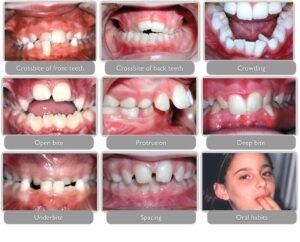What is it?
Malocclusion refers to misalignment or incorrect positioning of the teeth when the jaws are closed. It can manifest in various forms, affecting the way the upper and lower teeth fit together, also known as occlusion. Malocclusion may result from genetic factors, developmental issues, habits, or injuries, and it can lead to problems with chewing, speech, and oral health.
Here are some key points about malocclusion:
- Types: Malocclusion can present in different forms, including:
- Overbite: The upper front teeth excessively overlap the lower front teeth vertically.
- Underbite: The lower front teeth protrude forward beyond the upper front teeth, creating an abnormal bite.
- Crossbite: One or more upper teeth sit inside the lower teeth rather than outside when the jaws are closed.
- Open bite: There is a space between the upper and lower front or side teeth when the jaws are closed, preventing them from meeting properly.
- Crowding: Insufficient space in the dental arch causes teeth to overlap or become crooked.
- Spacing: Excessive gaps or spaces between teeth due to missing teeth or abnormal growth.
- Misalignment: Teeth may be rotated, tilted, or displaced from their proper positions within the dental arch.
- Causes:
- Genetics: Malocclusion can run in families, indicating a genetic predisposition to certain dental and jaw traits.
- Developmental factors: Irregular tooth eruption, abnormal growth of the jawbones, or facial trauma during childhood can contribute to malocclusion.
- Oral habits: Thumb sucking, tongue thrusting, prolonged pacifier use, or mouth breathing can affect dental and facial development, leading to malocclusion.
- Dental conditions: Early loss of primary (baby) teeth, impacted teeth, or dental restorations that alter tooth alignment can cause malocclusion.
- Skeletal abnormalities: Abnormal growth patterns or structural anomalies of the jawbones can result in malocclusion.
- Symptoms:
- Difficulty biting or chewing food properly.
- Speech problems, such as lisping or difficulty pronouncing certain sounds.
- Jaw pain, discomfort, or tension.
- Temporomandibular joint (TMJ) disorders, including clicking, popping, or locking of the jaw.
- Uneven wear of tooth surfaces or premature tooth wear.
- Self-consciousness about the appearance of the smile or facial profile.
- Diagnosis:
- Diagnosis of malocclusion involves a comprehensive dental examination, which may include:
- Visual assessment of tooth alignment, jaw relationship, and facial symmetry.
- Dental impressions, X-rays, or digital scans to evaluate tooth and jaw relationships more precisely.
- Bite analysis to assess occlusal discrepancies and functional issues during jaw movement.
- Treatment:
- Treatment options for malocclusion depend on the type and severity of the condition, as well as the individual’s age and oral health needs. Treatment may include:
- Orthodontic treatment: Braces, clear aligners, or other orthodontic appliances are used to move teeth into their proper positions and correct bite discrepancies.
- Tooth extractions: In cases of severe crowding, impacted teeth, or skeletal discrepancies, extractions may be necessary to create space or facilitate orthodontic treatment.
- Jaw surgery (orthognathic surgery): For significant skeletal malocclusion or jaw misalignment, surgical intervention may be required to reposition the jaws and achieve proper occlusion.
- Dental restorations: Crowns, veneers, or dental implants may be used to restore tooth alignment, improve aesthetics, and enhance occlusal function.
- Oral appliances: In some cases, removable or fixed appliances may be prescribed to address specific functional or developmental issues, such as thumb sucking or tongue thrusting.
In summary, malocclusion refers to misalignment or incorrect positioning of the teeth and jaws when the mouth is closed. It can manifest in various forms and may result from genetic factors, developmental issues, habits, or injuries. Malocclusion can lead to problems with chewing, speech, and oral health, but it can often be successfully treated with orthodontic interventions, dental restorations, or surgical procedures, depending on the individual’s needs and the severity of the condition. Early diagnosis and appropriate treatment are essential for addressing malocclusion and improving oral function, aesthetics, and overall well-being.

